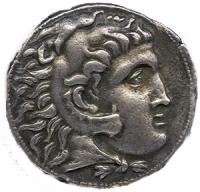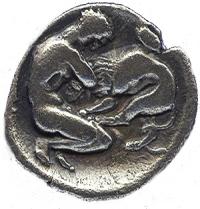Herakles and the Nemean Lion
Learn more about the object below
It might seem irreverent to modern viewers if Americans considered printing the face of a god on the dollar bill, but the ancient Greeks and Romans thought differently. Casting Herakles' face onto ancient currency commemorated his position in myths and religion, just as printing the faces of previous American presidents on modern money is a tribute to the service they gave to the their country. Later Greek and Roman coins depicted rulers as well as gods, distributing their portraits to people who even lived far away from their leaders. Rulers took this double-sided opportunity to appear with favorable symbols or divinities to give themselves a positive public image, close to divine. In these examples from Mount Holyoke's collection, Alexander the Great promotes his close association with Herakles by wearing his guise.
The Greek goddess Hera hated that Herakles was an illegitimate son of her husband, Zeus, and punished him his whole life. She sent a fit of madness that caused Herakles to kill his family. To avenge them and purge his sins, Herakles' cousin, Eurystheus, assigned him his twelve labors, which included killing the Hydra and the Nemean Lion. The reverse face of this coin depicts Herakles pulling the lion apart with his bare hands. Object 21 depicts another labor, stealing the belt of the Amazon Queen. To Eurystheus' dismay, Herakles accomplished all his tasks and gained great fame and immortality. Legendarily, even Hera forgave him.
Label text by Sarah Jenkins (MHC, '12)
Suggested readings:
Vanessa James, The Genealogy of Greek Mythology (New York: Pengiun, 2003), 93.
W.V. Harris ed., The Monetary Systems of the Greeks and Romans (Oxford: Oxford University Press, 2008).
G.K. Jenkins, Ancient Greek Coins (Trowbridge: Cromwell Press, 1990), 45-49.
Cotterell, A Dictionary of World Mythology. (Oxford: Oxford University Press, 1990).




